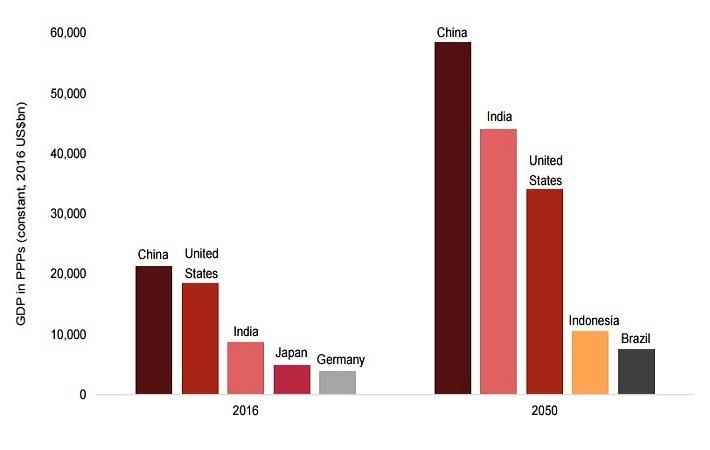Interviews
News Flash
Indian economy to overtake US in PPP terms by 2040: PwC
09 Feb '17
2 min read

Chart showing increasing gap between the third and fourth largest economies; Courtesy: PwC
India would be at No. 2 in global GDP ranking at purchasing power parity (PPP) terms by 2040, behind China but ahead of the US, says a latest report. With cumulative global GDP growth of 130 per cent between 2016 and 2050, the world economy could more than double in size by 2050 due to continued technology-driven productivity improvements, the report adds.
Emerging markets (E7) could grow around twice as fast as advanced economies (G7) on average, and as a result, six of the seven largest economies in the world are projected to be emerging economies in 2050, says the PricewaterhouseCoopers(PwC) report ‘The World in 2050’.
E7 economies comprising Brazil, China, India, Indonesia, Mexico, Russia and Turkey would grow at an annual average rate of almost 3.5 per cent over the next 34 years, compared to just 1.6 per cent for the advanced G7 nations of Canada, France, Germany, Italy, Japan, the UK and the US, according to the report.
“In fact, China has already overtaken the US to become the world’s largest economy in PPP terms, while India currently stands in third place and is projected to overtake the US by 2040 in PPP terms,” PwC said.
The report predicts Vietnam, India and Bangladesh to be three of the world’s fastest growing economies during 2016-2050. “The US could be down to third place in the global GDP rankings while the EU27’s share of world GDP could fall below 10 per cent by 2050.”
“UK could be down to 10th place by 2050, France out of the top 10 and Italy out of the top 20 as they are overtaken by faster growing emerging economies like Mexico, Turkey and Vietnam respectively,” states the report.
However, emerging economies would need to enhance their institutions and their infrastructure significantly if they are to realise their long-term growth potential.
“From a business perspective, there is also a need to look beyond short-term economic volatility in both advanced and emerging economies and develop strategies that have the right balance of flexibility and patience,” says John Hawksworth, chief economist, PwC UK. (RKS)
Fibre2Fashion News Desk – India
Popular News
Leave your Comments
Editor’s Pick
































-Ltd..jpg?tr=w-120,h-60,c-at_max,cm-pad_resize,bg-ffffff)





.jpg?tr=w-120,h-60,c-at_max,cm-pad_resize,bg-ffffff)
.jpg?tr=w-120,h-60,c-at_max,cm-pad_resize,bg-ffffff)






